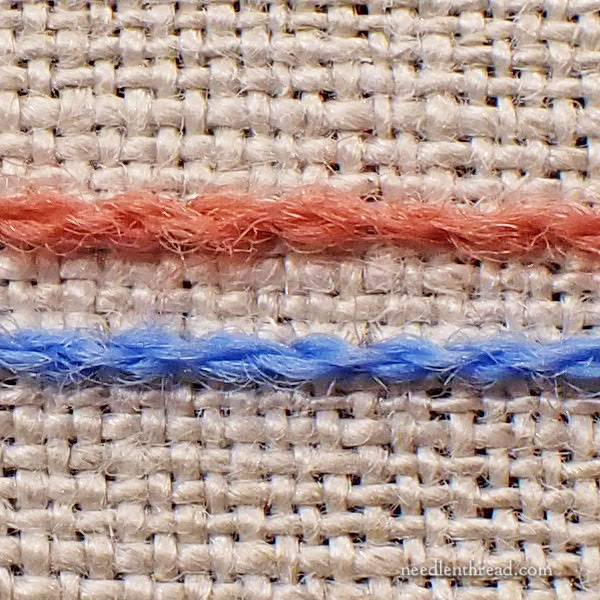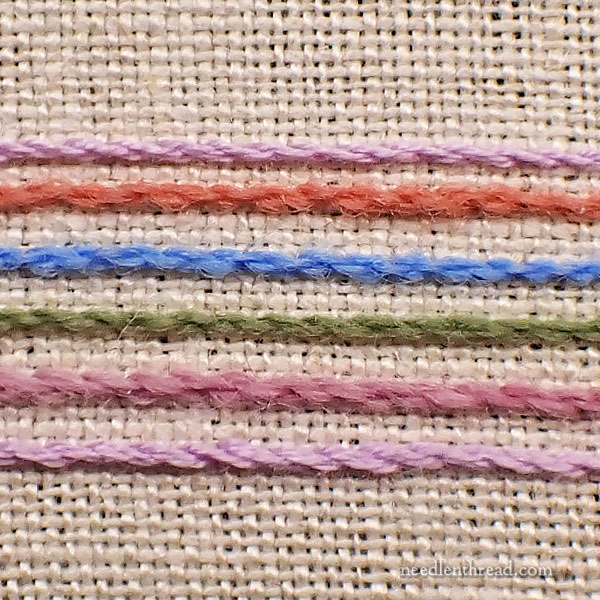Following up on this previous article comparing crewel wool embroidery threads, today we’re going to look at a few stitched samples of these threads so you can see how they work up.
News: The Purple Posy stitch-along installment that should have been posted today is postponed until next week, due to some eye problems and medical issues that I’m currently dealing with. As soon as I can spend a little more time on the computer, I will finish those lessons up and get them posted. I hope to be able to finish them up this weekend! Keep your fingers crossed that my eyes cooperate – they are recovering from another ocular stroke and subsequent blind spot.

At first glance, the four lines of stem stitch in the photo above all look pretty close to identical, with the exception of their color. Each line, however, is slightly different.

From our previous explorations, we are looking at four brands of crewel wool: Appleton, Fine d’Aubusson, Heathway, and DMC’s Eco Vita.
I’ve stitched all four of them using stem stitch, with the same spacing and using the same size needle (#7 crewel needle).

When you look at the Appleton and the Fine d’Aubusson up close like this, you can see that Appleton is definitely a fuller thread, especially that it is not as tightly twisted as the Fine d’Aubusson and that it looks significantly more fuzzy.
And this is true. The Appleton is definitely more loosely twisted and it is fuzzier. The Fine d’Aubusson stitches up quite a bit finer, and it is much smoother. There is a distinct difference in feel between both threads. FdA is more pleasant to stitch with, it does not tend to twist as much, and it does not drag through the fabric.
Appleton’s tends to pill a little when you stitch with it – it’s very important to use shorter lengths of Appleton wool, if you want to avoid pilling and fraying.
FdA does not pill as much. I won’t say it never pills, because sometimes, you will find a stray little blob of wool that’s built up on the side of the thread. But it’s pretty rare. It’s just a smoother thread overall.
Fine d’Aubusson has more sheen than Appleton’s.

You can see that the Heathway (green) seems slightly finer even than the Fine d’Aubusson. It’s not, really. I would put those two threads about at the same “weight” as far as their stitched thickness goes.
Heathway pulls itself in a bit more when you stitch with it, because it tends to be a little more “boingy” than the other wools. (Fine d’Aubusson has very little boing, by the way, so it doesn’t change much, even if your tension changes.)
Heathway stitches up into an incredibly smooth feeling thread – very … soft and buttery. And it has a great “spread” when working filling stitches like satin stitch and long and short stitch. It also has a very nice sheen.

DMC’s Eco Vita (pink) stitches up at about the same “weight” or thickness of line as the Appleton’s, visually – although I would say it is every-so-slightly heavier than the stitched Appleton line.
Eco Vita is a slightly heavier thread than the Appleton’s. I found I had to use a larger needle with the Eco Vita. It preferred something bigger than the #7, although it still works with the #7. It was definitely easier to thread a needle larger than a #7. (So, a #6 or even a #5 would work.)
There is a bit of boing to the Eco Vita, and it is more loosely twisted like the Appletons, so it has a bit more “fuzz” to it.
I felt a distinct drag on the Eco Vita as I pulled it through previous stitches (when working long and short stitch and split stitch), especially when I was using the smaller $7 needle.
If you feel a drag on this thread (or any wool thread), it helps to needle up. (Increase the size of your needle.)
Like the Fine d’Aubsson, the Eco Vita does not have much “boing” (or bounce). It does not tend to twist much as you stitch with it. But it is slightly fuzzier, so it is more common to see some “pilling” now and then. If you are prone to use longer threads when you embroider, remember that, with wool, it’s better to use slightly shorter threads than you normally would, because of the friction fro the fabric on the wool.
I fine Eco Vita pleasant to stitch with. It’s not as buttery smooth and soft as Heathway, not quite as tightly twisted and smooth as Fine d’Aubusson, and it is (thankfully) not as rustic-feeling as Appleton.

In the photo above, I added two more lines of stitching – in pink – at the top and bottom of the wool threads. The top line is two strands of DMC cotton floss. The bottom line is three strands of DMC cotton floss.
This gives you a gauge to understand the weight of the crewel wool.
I would put Fine d’Aubusson and Heathway a little closer to the same weight or thickness of a line stitched with two strands of cotton floss. I would put Appleton’s and Eco Vita closer to a line stitched with three strands of DMC cotton floss.

But Wait, There’s More!
Next time, we’ll look at filling stitches with these wool threads – specifically, shaded filling and satin stitch.
In the meantime, if you’re hankering to try DMC’s Eco Vita, I’m carrying a limited edition 30-skein collection box of Eco Vita – with a gorgeous range of natural colors – here in my shop.
It includes a nice selection from the 60-skein range, housed attractively in an ivory colored sturdy cardboard flat box. The 30-skein collection (with full skeins) will give you plenty of scope for embroidery with this organic, naturally-dyed wool. I love the muted palette – it’s so pretty! – and I think you will, too!







Gosh, between you and Yvette Stanton, the embroidery world is so sad to hear these health issues. I will be keeping you in my prayers. Get well soon, Mary.
Thanks so much, Carol!
I will pray for your eyesight. You add so much beauty to the world!
Thanks, Patty! 🙂
hope you have a quick recovery with no negative residuals!
Thanks, Katherine! 🙂
Mary, please be well!
I’m working on it! 🙂
Some people have said that Appleton wool has a smooth direction and a rough direction. That if you run your fingers down the yarn you can find the smooth direction and avoid pilling.
Years ago the same was said to be true with Persian wool. Then some scientists did studies and said wool threads had no directions.
Is this still an urban myth? I too noticed that Appleton pills a lot. But then I will have strands with no pilling at all.
Just got the new DMC wool and really like it.
Regards, Darcy
It is an urban myth. I wrote an article about it here. I actually spoke to thread manufacturers and to experts in the field of fiber, to explore the topic. People also say it about mercerized cotton, like DMC. It’s really not the case. Here’s the article: https://www.needlenthread.com/2015/08/thread-talk-the-debate-i-dont-want-to-have.html
God Bless You & i’ll be praying for you & your special intentions.